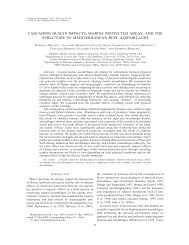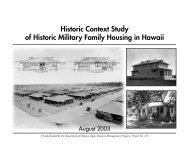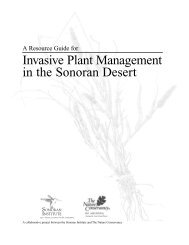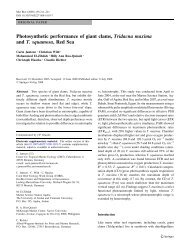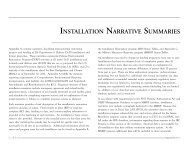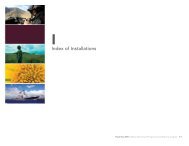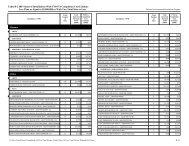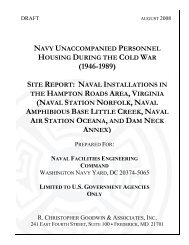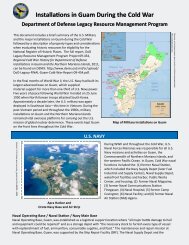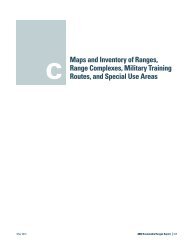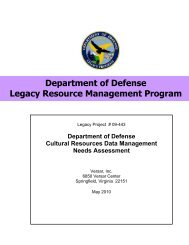Appendix M: Installation Narrative Summaries - denix
Appendix M: Installation Narrative Summaries - denix
Appendix M: Installation Narrative Summaries - denix
You also want an ePaper? Increase the reach of your titles
YUMPU automatically turns print PDFs into web optimized ePapers that Google loves.
u����2e��2p���2f—�� f‚eg2IWWS<br />
2ppshX<br />
2ƒ���X<br />
2w������X<br />
2r‚ƒ2ƒ���X<br />
2seq2ƒ�—���X<br />
2g���—���—���X<br />
2w���—2e������X<br />
2p������2��2h—��X<br />
€�������2„�2h—��<br />
In July 1995, the BRAC Commission recommended closure<br />
and realignment of Kelly Air Force Base (AFB). The Defense<br />
Distribution Depot, San Antonio, closed in July 2001, and the<br />
airfield and all associated support activities were realigned to<br />
Lackland AFB, Texas. Sites identified at the installation include<br />
landfills, spill sites, former fire training areas, low-level<br />
radioactive waste sites, underground storage tanks, aircraft<br />
maintenance areas, sludge lagoons, and sludge-spreading<br />
beds. The installation formed a Restoration Advisory Board<br />
(RAB) in FY94. In FY96, a BRAC cleanup team (BCT) was<br />
formed and the first BRAC cleanup plan was issued. In FY99,<br />
the installation received technical assistance for public<br />
participation (TAPP) funding that allowed the RAB to review the<br />
basewide groundwater assessment and the Agency for Toxic<br />
Substances and Disease Registry (ATSDR) public health<br />
assessment. The installation completed a 5-year review in<br />
FY06.<br />
Investigations identified 52 <strong>Installation</strong> Restoration Program<br />
(IRP) sites and several areas of interest at the installation. This<br />
includes 35 IRP sites that have been identified on the<br />
non-realigned (BRAC) portion of this installation. Sites were<br />
separated into five zones. Two range sites have also been<br />
identified. To date, the installation has transferred<br />
approximately 428 acres to the local redevelopment authority<br />
(LRA). The cleanup progress at Kelly AFB for FY02 through<br />
FY05 is detailed below.<br />
In FY02, the installation removed inactive portions of the former<br />
industrial wastewater treatment plant (IWTP). Also, a<br />
permeable reactive barrier to contain groundwater at the base<br />
boundary and a bioaugmentation system to treat the<br />
warehouse area groundwater source were installed. The<br />
installation submitted the Zones 4 and 5 draft final corrective<br />
measures studies (CMSs) for the off-base shallow groundwater<br />
contamination to regulators. Groundwater containment trenches<br />
were installed at a former evaporation pit and at a fuel spill site.<br />
Soil removal was completed and installation of another<br />
groundwater containment trench began at an IRP site. A<br />
bioaugmentation remedy was installed on East Kelly, and<br />
excavation of acidic tar materials began at the far south side of<br />
the base. The last aboveground fuel storage tank was<br />
demolished and the soil was removed as needed. Construction<br />
Air Force<br />
„ˆTSUIUPRQQQHH<br />
QDWWU2—���<br />
€������2�����E�����2—���—��2—��2������2���—��<br />
xGe<br />
x���<br />
w��—��D2†yg�D2ƒ†yg�<br />
q������—���2—��2����<br />
62PSQFR2�������<br />
2i��F2g„g2@g���2‰�—�AX 62UWFV2�������@p‰2PHPQA<br />
2s‚€Gww‚€2ƒ����2p��—�2‚s€G‚gX p‰2PHHTGp‰2PHHU<br />
2p���E‰�—�2‚�����2ƒ�—���X g��������2—��2��—����<br />
of a groundwater treatment plant on the north end of the base<br />
began. Five RAB meetings were held. Three TAPP reviews<br />
were conducted to evaluate proposed cleanup plans for two<br />
sites and an ATSDR public health assessment. Several other<br />
partnerships were established with the community and<br />
regulatory agencies to address public health issues.<br />
In FY03, the installation awarded design and construction<br />
contracts for two permeable reactive barriers in off-base<br />
residential areas. Petroleum storage tank removals were<br />
completed and one tank site was closed. Ten no further action<br />
determinations were approved for radiological sites. The<br />
installation decontaminated and demolished building and<br />
interior sewer lines with low-level radiological contamination.<br />
Twenty-six low-level radiological sites were closed. The<br />
installation submitted and obtained conditional approval of<br />
shallow groundwater CMSs. Additional protective measures<br />
were completed through a unique partnership with several<br />
agencies. Demonstration projects for injection technology were<br />
conducted and 6.5 acres were transferred by deed to the LRA.<br />
In FY04, the installation transferred 107 acres to the LRA. The<br />
Air Force installed Zone 5 and began construction of Zone 4<br />
off-base shallow groundwater remedies. The installation also<br />
completed the demolition and cleanup of the former IWTP and<br />
began construction of the final IRP groundwater and soil<br />
remedies in Zone 2. Additionally, the installation completed<br />
installation of final IRP groundwater remedies in Zone 3. The<br />
Air Force conducted an inventory of Military Munitions<br />
Response Program (MMRP) sites. MMRP sites were identified<br />
at this installation. The community relations plan was updated<br />
to indicate the status of remediation efforts and identify ongoing<br />
opportunities for community involvement.<br />
In FY05, the Air Force completed installation of the Zone 4<br />
off-base shallow groundwater remedies. The installation<br />
submitted the closure report for the former IWTP. Discussions<br />
between the installation and regulators continued on the<br />
ecological risk report for Leon Creek. The installation completed<br />
construction of the final IRP groundwater and soil remedies in<br />
Zone 2. The Air Force began evaluating requirements at MMRP<br />
sites at this installation. The RAB continued to meet quarterly;<br />
the BCT continued to meet once a month.<br />
p‰HT2s‚€2€�������<br />
The installation continued long-term management (LTM) and<br />
operations of remedial systems. The Air Force submitted a<br />
Class 3 modification to the RCRA compliance plan to regulators<br />
for approval of final remedies for Zones 4 and 5 sites, including<br />
remedies for the off-base shallow groundwater. Regulators<br />
approved the Tier 2/Tier 3 ecological risk assessment and the<br />
Zones 2 and 3 CMSs. The installation completed the first 5-year<br />
review and submitted it to regulators. Regulators approved<br />
closure of 10 IRP sites in Zone 2. The Air Force transferred<br />
approximately 106 acres to the LRA. The cost of completing<br />
environmental restoration has changed significantly due to<br />
technical issues and changes in estimating criteria.<br />
The RAB met quarterly. Five BCT meetings were held.<br />
ƒ—�2e������D2„��—�<br />
p‰HT2ww‚€2€�������<br />
The Air Force developed a sampling plan for soils associated<br />
with the small arms firing range.<br />
€�—�2��2e����<br />
Plan of action items for Kelly Air Force Base are grouped below<br />
according to program category.<br />
22222s‚€<br />
0 Continue LTM and operations of remedial<br />
systems in FY07-FY08.<br />
0 Submit Class 3 modification to the RCRA<br />
compliance plan to regulators for approval of<br />
the final remedies for Zones 2 and 3 sites<br />
in FY07-FY08.<br />
0 Install soil remedies at five Zone 3 sites<br />
and submit closure report for Site D 10 in<br />
FY07-FY08.<br />
0 Prepare operating properly and sucessfully<br />
determination reports for Zones 4 and 5<br />
remedial systems in FY07-FY08.<br />
22222ww‚€<br />
0 Sample soils associated with small arms<br />
firing range following demolition of Building<br />
3430 in FY07-FY08.<br />
M-107




